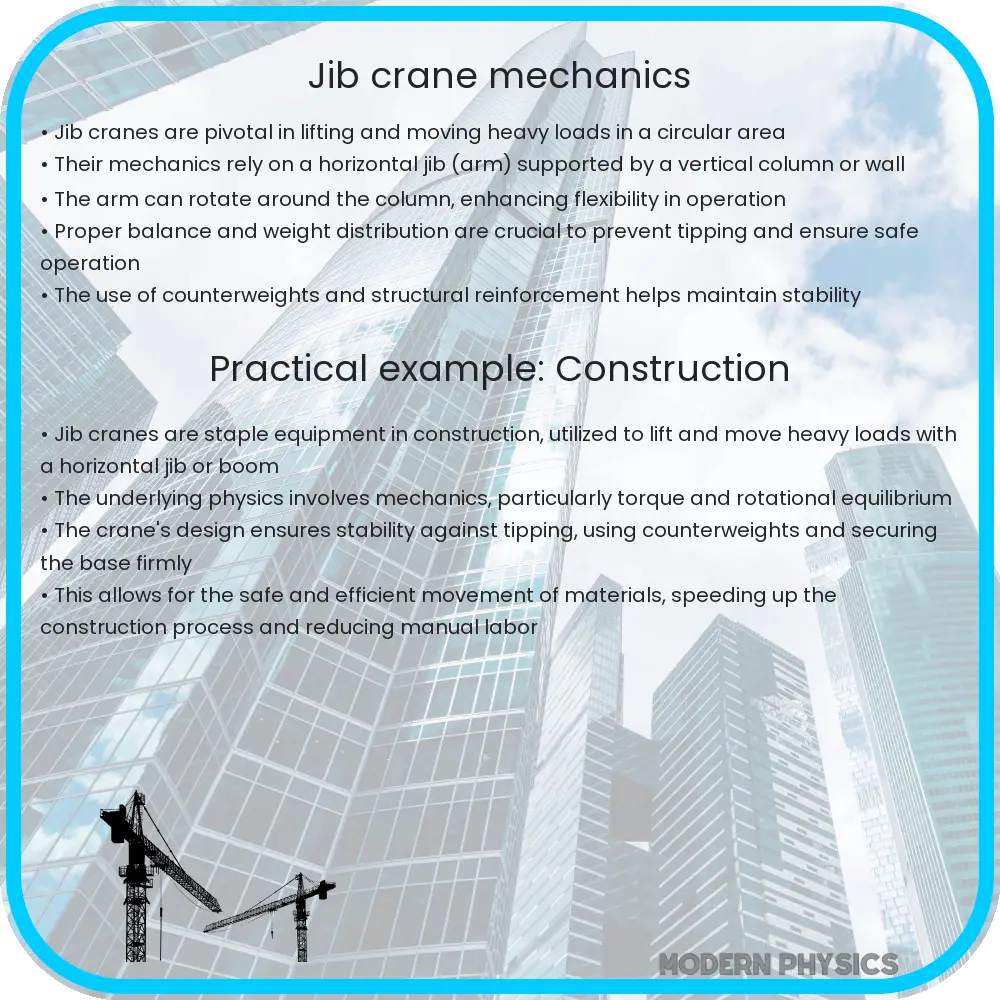Explore the mechanics of jib cranes, focusing on load balance, stability, and stress, with insights into safety measures and technological advancements.

Understanding Jib Crane Mechanics: Load Balance, Stability, and Stress
Jib cranes are vital in various industrial applications, known for their versatility and efficiency in material handling. Understanding the mechanics of a jib crane is essential for its safe and effective operation. This article delves into the key aspects of jib crane mechanics: load balance, stability, and stress.
Load Balance
Load balance in jib cranes is a crucial factor that influences their performance. It refers to the distribution of the load weight across the crane’s structure. An uneven load distribution can lead to tipping or mechanical failure. The load balance is governed by the crane’s design, particularly the length of the jib arm and the position of the hoist. It’s imperative to ensure that the load is well within the crane’s capacity and is positioned to maintain the center of gravity within the operational limits.
Stability
Stability is another paramount aspect in jib crane operations. It depends on factors such as the crane’s base design, mounting style, and the weight of the load. The stability of a jib crane is often challenged when the load is at its maximum reach, as this can shift the center of gravity and increase the risk of toppling. Engineers use specific calculations to ensure the crane’s design accommodates stability under various load conditions. These calculations take into account the moments of inertia and forces acting on the crane.
Stress Analysis
Stress analysis in jib cranes involves examining the stresses and strains that various components of the crane undergo during operation. Key points of stress include the jib arm, the pivot point, and the base. Materials used in crane construction must withstand these stresses without deforming or breaking. Engineers use finite element analysis (FEA) to simulate and assess the stress distribution within the crane structure. This analysis helps in identifying potential failure points and in designing cranes that are both strong and efficient.
For instance, the bending stress (σ) on the jib arm can be calculated using the formula:
σ = (My/I), where M is the moment of force, y is the distance from the neutral axis, and I is the moment of inertia.
Understanding these mechanics is not only essential for crane operators but also for those responsible for maintenance and safety protocols.
Practical Considerations in Jib Crane Mechanics
Alongside theoretical knowledge, practical considerations play a significant role in jib crane operation. One such factor is the wear and tear of mechanical parts over time, which can affect load balance and stability. Regular maintenance and inspections are crucial to ensure that all components are in good working condition. Additionally, environmental factors like wind, temperature, and seismic activity can also impact crane performance and should be taken into account in the crane’s design and operation.
Safety Measures
Safety is paramount in the operation of jib cranes. This includes not only adhering to load limits and operational protocols but also ensuring that all safety features are functional. Emergency stop systems, overload indicators, and regular safety drills for operators contribute significantly to preventing accidents. It’s also essential to keep up with the latest safety regulations and industry standards.
Technological Advancements
Technological advancements have a profound impact on the mechanics of jib cranes. Innovations like computer-aided design (CAD), real-time monitoring systems, and advanced materials have enhanced the efficiency, safety, and longevity of cranes. These technologies allow for more precise stress analysis, better load distribution, and improved overall crane performance.
Conclusion
Understanding the mechanics of jib cranes – load balance, stability, and stress – is essential for their efficient and safe operation. Balancing the load correctly, ensuring stability through careful design, and regularly analyzing stress points are fundamental for the longevity and safety of the crane. Practical considerations like maintenance, environmental factors, and technological advancements also play a significant role in optimizing crane performance. By adhering to these principles, industries can ensure that their jib cranes operate smoothly, safely, and effectively, contributing to a more productive and secure working environment.
